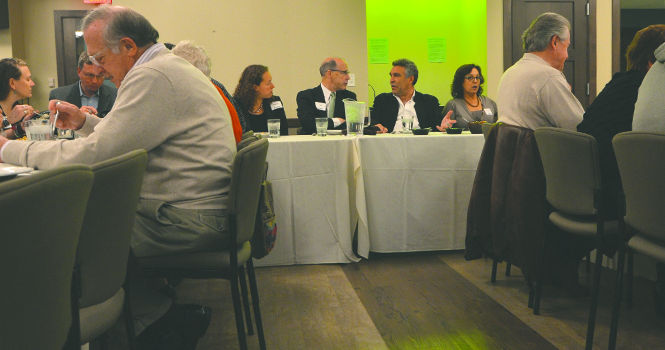Photographer shares gallery of exiled Jews
Frederick Brenner, a famous French photographer, has a private dinner in the Kent State Hillel on Oct. 29 before speaking to an audience in the KIVA about his experiences of documenting Jewish identity after the Holocaust. Photo by Jacob Byk.
October 30, 2012
World-renown photographer Frédéric Brenner spoke Monday at the Kiva about his journey to 40 countries over 25 years to capture the lifestyles of different Jews throughout the world.
Starting in 1979, Brenner began on his project, titled “Diaspora,” to shed light on Jews exiled from their homeland to other parts of the world. In fact, Diaspora literally means “exile.”
Brenner told the room of about 70 people of the stories he not only witnessed, but captured on film.
“I wanted to show what the community eventually became,” Brenner said. “I wanted to put a face on all the different Jewish men, women and children living throughout the world.”
Brenner said what he found was the new “portable identity” of the Jewish faith.
Brenner’s most captivating series of photos dated back to the late 70s and early 80s in the Soviet Union. There, Brenner was one of the first photographers allowed behind the Iron Curtain, and he was able to capture and tell stories of life in Communism.
“Jews were widespread over the 15 republics,” Brenner said. “I wanted to show their life through the religious and social entity they were living in, in the Soviet Union.”
Brenner was able to tell stories and explain each photograph during the entire presentation. After Brenner was done with his slides, an audience member asked how difficult it would be to connect with the photos without Brenner being there to give background.
“I did agree with the guy that asked the question of how he needed the presentation to go along with the pictures,” said sophomore exploratory major Jaclyn Hart. “I don’t think I would have been able to understand if I just saw the pictures alone.”
The different photos Brenner used ranged from serious ones, like Jews secretly worshiping in Portugal, to more light-hearted ones such as a Jewish biker group from the U.S.
Once Brenner was done presenting his work of 25 years, which ended in 2003, he showed photos from his new project that he began in 2007.
Brenner and 11 other photographers have been working on a project to show Israel in a new light. Each photographer spent periods of six months to over a year looking for different aspects of the country to show with pride for the Jewish faith.
“The idea was to expose the artists to a folk-line of this place,” Brenner said as he showed preview photos. “I would say that it was an unbelievable experience that really transformed each artist.”
His new still-untitled exhibit will open in 2014 in Europe.
Contact Matt Lofgren at [email protected].

























